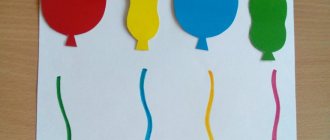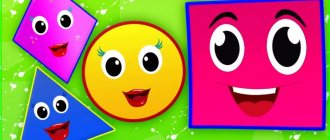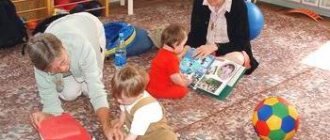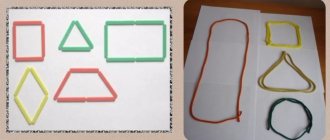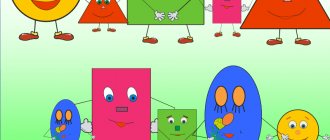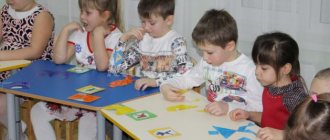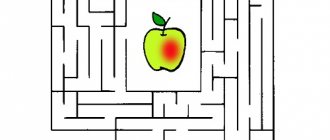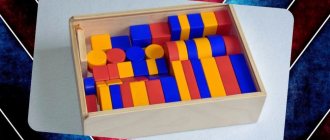Interactive game “First steps into the world of mathematics”
- April 13, 2021
The formation of mathematical concepts is not limited to mathematics classes alone, but is included in the context of all other traditional and innovative activities in kindergarten.
One such innovative activity is an interactive educational game. Goal: development of elementary mathematical concepts in young preschoolers.
Tasks:
- Development of the ability to independently find an object in relation to identity (the same as ...), focusing simultaneously on two properties (color and shape, color and size).
- Development of the ability to independently distinguish groups by the number of their constituent objects (one, two, three) based on visual perception and counting.
- Correlating a number (quantity) with a figure.
- Exercise in naming colors, shapes, sizes of objects, numbers.
- Develop activity and independence of cognition.
Audience: the interactive educational game “First Steps into the World of Mathematics” can be used to teach children of primary preschool age within the educational field of “Cognition” in a preschool educational institution, and is also recommended for classes for parents with children in the family circle.
Contents of the interactive game: each slide contains a task. Selecting the correct answers in each task of the game is done by clicking on the subject pictures. Correct and incorrect answers are accompanied by animation.
Equipment: computer, multimedia installation, screen.
Efficiency: the use of interactive games in the educational process in preschool educational institutions is one of the effective ways to increase motivation and individualize children's learning, develop their creative abilities and create a favorable emotional background. It also allows you to move from an explanatory and illustrated method of teaching to an activity-based one, in which the child takes an active part in this activity. This promotes conscious assimilation of new knowledge.
Practical significance: the interactive game “First Steps into the World of Mathematics” consists of a set of game tasks aimed at developing elementary mathematical concepts in young preschoolers.
Interactive educational game “First steps into the world of mathematics”
Author: Anna Vladimirovna Ulyanova, teacher, MBDOU No. 122, Murmansk. 2 years of experience.
Presentation “Entertaining mathematics” for children of senior preschool age
Explanatory note to the presentation on the development of mathematical concepts “Entertaining mathematics” for children of senior preschool age
Author: Vanyukova Svetlana Leonidovna,
teacher
MDOU "Finno-Ugric kindergarten"
combined type No. 20 “Lumichello”,
Petrozavodsk city
Target:
Forming children's interest in mathematics using multimedia technologies.
Tasks:
- improve counting skills within 10,
- develop the ability to solve logical problems,
- consolidate knowledge about temporary relationships,
- develop the ability to compare two groups of objects and establish relationships between objects: “more, less, equal”,
— train children in solving examples on addition and. subtraction within 10,
- develop logical thinking, visual perception, voluntary attention, fine motor skills.
The target audience:
children of senior preschool age 6-7 years old.
Materials and equipment:
laptop, presentation, interactive whiteboard, printouts with assignments.
Note:
Slide 2 has built-in hyperlinks (in the images of the balls) that redirect to the slides with the task. After discussing, the children choose which color ball they will press. Returning to the slide with heroes is done by clicking on the cloud image. The text of the characters’ assignments is read by the teacher (or you can make an audio recording and embed it in the presentation).
On slide 3, the answer appears by clicking on the images of the books.
On slide 4, to check whether the task was completed correctly, you need to click on each ball.
On slide 5, to change the task, click on the orange arrow in the lower right corner. Children answer by showing cards with the color of the clock. The answer is checked by clicking on the image of the clock (if you answer incorrectly, the image will disappear).
On slides 8 and 9, the answer appears by clicking on the task card.
Having completed all the tasks, the teacher sums up the lesson.
Tasks that require individual completion and develop the graphic skills of preschoolers should be printed out for each child (tasks from slides 8, 9).
“Entertaining mathematics” PPTX / 10.81 MB
Tasks included in the presentation:
Logical task “Find the book”
Target:
develop logical thinking and intelligence.
Logic problem “Balls”
Target:
teach children to divide the whole into parts and establish connections between them.
Task “Tell the time”
Target:
consolidate temporary relationships in children of older preschool age.
Task “Solve Examples”
Target:
strengthen the ability to solve examples on addition and subtraction.
Task “Place the right sign”
Target:
develop the ability to understand the relationships of adjacent numbers.
List of used Internet sources:
https://mishutkina-shkola.rf/98/75.jpg
https://media.istockphoto.com/photos/wall-clock-isolated-on-white-background-seven-oclock-picture-id1029298410?k=6&m=1029298410&s=612×612&w=0&h=XYmPt5TR2CN9-UIMyk9YSSz4ldUQjk0kPtTNu7Cla0I=
Summary of GCD on FEMP using ICT “Journey to Treasure Island” for children of the senior group
Summary of direct educational activities on cognitive development (FEMP) on the topic “Travel to Treasure Island” for children of the older group (5-6 years old)
Prepared by teacher: Irina Anatolyevna Klimova Priority educational area: “Cognitive development” Integration of educational areas: “Social - communicative ", "Speech development", "Physical development" Types of activities: cognitive, gaming, communicative, musical. Goal: to create conditions for the development of logical thinking, intelligence, attention and demonstrate the skills of complex application of mathematical concepts, knowledge and methods of action, as well as the ability to practically use them through a game - a journey. Program objectives: Educational:
• To consolidate knowledge of the number series, to correctly use cardinal and ordinal numbers, to count within 7. • To consolidate the ability to compare objects of different sizes, placing them in a row in ascending (descending) height order.
• Consolidate knowledge of geometric shapes. • Strengthen the ability to name the days of the week, the sequence of parts of the day. Developmental:
• Develop mental operations, attention, memory, speech, fantasy, imagination, logical thinking, creative abilities.
Educational:
• Cultivate interest in mathematics.
Methodological techniques: demonstration, questions, explanation, game. Preliminary work: individual work with children to consolidate the children’s knowledge acquired in the classroom. Materials and equipment: interactive whiteboard, projector, laptop, presentation “Journey to Treasure Island”, map - poster with a plan, chips - magnets for the map that will indicate the completed task, envelopes with tasks in the form of geometric shapes, chest, prizes in the form chocolate coins; handouts: two-color card, squares and circles, sheet of paper, colored pencils.
Progress of the lesson. Introductory part. Slide 1 Organizational moment - Today guests came to us to see what wonderful children attend our kindergarten. Let's say hello? Let’s stand side by side in a circle and say “Hello!” each other. We are not too lazy to say hello - “Hello!” to everyone! and “Good afternoon!” If everyone smiles, a good morning will begin! Hello!
Guys, today we will go to a desert island (Slide 2), where Pirate Jack and his crew live (Slide 3).
Our task is to find a chest with gold coins and jewelry (Slide 4).
But the path to these treasures is long and difficult, and we will need to complete many different tasks. Captain Veselchak
(Slide 5), whom Pirate Jack captured, will help us in our search. And how, we will find out only after we read his message (Slide 6).
How will we get to the island?
That's right, on a ship! Well, let's swim? (Children imitate rowing with oars). Main part Here we are on the island. Look, this is a map - it will tell us whether we are moving correctly. We will mark each stage we pass so as not to lose our way. Guys, pay attention to the board - here we have tasks from Captain Veselchak. (Slide 7).
Card with task No. 1. I will ask, and you answer quickly. Ready? — What time of year is it now? (autumn) (Slide
Ready? — What time of year is it now? (autumn) (Slide
— How many autumn months are there in total? (3) - List all the autumn months? (September, October, November) - What day of the week is it today? (Tuesday) - What was it like yesterday? (Monday). What will it be like tomorrow? (Wednesday) - How many days are there in a week? (7) - What is the name of the part of the day when we wake up, wash and brush our teeth, do exercises and go to kindergarten? (morning) - What is the name of the part of the day when children play in the kindergarten and have lunch? (day) - What is the name of the part of the day when children go home from kindergarten? (evening) - What time of day is it when we go to bed? (night) Let us repeat to you once again that the day consists of four parts: morning, day, evening and night (Slide 9).
- Well done guys, you completed the task! Children mark the completed stage on the map. Card with task No. 2. -To advance further, we need to complete the following task. Let's play a game called "Plant palm trees in a row." (Slide 10).
- Let's arrange the palm trees in a row, starting with the shortest and ending with the tallest. (Previously, the children remember the rules for arranging objects - from left to right)
- What is the height of the first palm tree?
(lowest) - What is the height of the last palm tree? (the tallest) - Let’s now tell you about each palm tree, how tall is it? (lowest, lowest, slightly higher, highest) - Well done, you completed this task! Children mark the completed stage on the map. Card with task No. 3. Guys, in order to be strong and brave, we are invited to complete the following task - to recharge ourselves a little. Physical warm-up How many dots will there be in the circle, (Slide 11) How many times will we raise our hands (4). How many green Christmas trees are there (Slide 12) How many bends will we perform (3). We squat as many times as possible (Slide 13) How many butterflies do we have (3). And we’ll stomp as many times as possible (Slide 14) How many hedgehogs we have (4). And we’ll slam it as many times as possible (Slide 15) How many squirrels we have (5). Children mark the completed stage on the map.
Card with task No. 4.
Let's read the next note from Captain Veselchak.
— On your tables you see long cards with two stripes. Now you and I will complete one more task, and we will be one step closer to the treasures of pirate Jack. Listen to me carefully. - You need to put 6 squares on the top strip (Slide 16), and 1 circle more on the bottom strip. (How many circles do you need to put on the bottom strip?). After execution, the correct answer appears
. - Where do we have more pieces, on the bottom or top strip? What is more than 6 or 7? — How can we make sure that there are equal numbers of figures on both stripes? (add 1 square). If you remove 1 circle, what else can you do to make the figures equal? (remove 1 square).
- Well done, you are doing everything right!
We completed the task! Children mark the completed stage on the map. Task card No. 5. — Here is a task on sheets of paper, for attentiveness (Slide 17). But first, let's prepare our fingers for work. Finger gymnastics To visit the big finger, we ran straight to the house: Index and middle, ring and last.
Here is the little finger, the little one, knocking on the threshold. Together fingers are friends. They can't live without each other! — Everyone has blank sheets of paper and pencils on their desks. Our task “I find my way around on a piece of paper.” Draw a red triangle in the lower left corner; in the upper right there is a blue square; in the lower right – a green circle; in the upper left there is a yellow oval. Now let's check if you did it right.
- Very good, we did it.
Children mark the completed stage on the map. Card with task No. 6. Guys, now we’ll take a break and dream a little. - Game “Funny numbers”. -What do these numbers look like? (Guys, answer in complete sentences) (Slides 18-23) Children mark the completed stage on the map. Card with task No. 7.
- Well, guys, we have completed almost all the tasks, we are already very close to the chest.
But we need to find him. There's a plan here. Guys, help me. Let's move from the board forward 5 steps, to the right 3 steps, forward again 2 steps and perhaps we will find something. (We find a castle on a desert island. Pirate Jack comes out of the castle and has a treasure chest in his hands). Final part Jack:
- Yes, guys, you turned out to be much smarter and more cunning than I thought, so I decided to release the Captain, who sent you all the tasks, and give you this chest (Slide 24).
Educator:
- Jack, the chest is closed.
Jack:
- Guys, I will reveal these treasures to you when you tell me what you did in class today, what did you do to find the treasures?
(Children's answers)
They open the chest together with the pirate Jack. (Slide 25).
You deserve these treasures, receive them - this is a reward for your work, for the fact that you answered well and always coped with tasks. Well done! Educator: Goodbye, Jack! And it's time for us guys to go back. Well, let's sail! Thank you for your attention! (Slide 26)
Self-analysis of direct educational activities on cognitive development (FEMP) on the topic: “Journey to Treasure Island” for children of the older group (5-6 years old)
Prepared by teacher: Irina Anatolyevna Klimova Priority educational area: “Cognitive development” Integration of educational areas: “Social - communicative”, “Physical development” Types of activities: cognitive, gaming, communicative, musical. Goal: to create conditions for the development of logical thinking, intelligence, attention and demonstrate the skills of complex application of mathematical concepts, knowledge and methods of action, as well as the ability to practically use them through a game - a journey. Program objectives: Educational: • To consolidate knowledge of the number series, to correctly use cardinal and ordinal numbers, to count within 8. • To consolidate the ability to compare objects of different sizes, placing them in a row in ascending (descending) order of length and height. • Consolidate knowledge of geometric shapes. • Strengthen the ability to name the days of the week, the sequence of parts of the day. Developmental: • Develop mental operations, attention, memory, speech, fantasy, imagination, logical thinking, creative abilities. Educational: • Cultivate interest in mathematics. Preliminary work: individual work with children to consolidate the children’s knowledge acquired in the classroom. Materials and equipment: interactive whiteboard, projector, laptop, presentation “Journey to Treasure Island”, map-poster with a plan, small geometric figures for the map that will indicate the task completed, envelopes with tasks in the form of geometric figures, a message from the captain to A4, flat numbered blanks of stones, “palm trees” (of varying heights), two-color stripe, handouts (rectangles and ovals), chest, prizes in the form of chocolate coins. Forms of organization: frontal, individual, group. Form of implementation (methodological techniques): use of manuals, musical accompaniment, demonstration of illustrative aids, ICT; searching and problematic questions for children, encouragement, explanation, leading to a conclusion; creation of play motivation, active activity of children, surprise moment. The OD OD structure was carried out with a group of older children aged 5-6 years, and consisted of three interconnected parts, during which the children gradually performed various actions. The introductory part is the organization of children, motivation for upcoming activities. At the organizational stage of the NOD, the problem-situational method was used. The children were invited to go on a journey to the island. The main part of the educational activity was organized and independent activities of children aimed at solving assigned tasks. Throughout the entire process, the NOD created problematic situations to solve the assigned tasks. In the final part of the GCD, a surprise moment awaited the children (chocolate coins). To implement each task, I selected techniques that helped solve them. The techniques were based on playful learning situations in which I tried to encourage children to engage in active speech activity. When working with children, I used conversation, questions to children for intelligence and logical thinking - all this contributed to the effectiveness of GCD, mental activity and the development of children’s speech. The material for GCD was selected at a level accessible to children, corresponded to their psychological characteristics and was rational for solving the problem goals and objectives. The children were active, attentive, and felt comfortable. All elements of GCD are logically united by a common theme. The content of the lesson corresponded to the assigned tasks. Activities at the educational activity are characterized as joint and individual. Methods: 1. Verbal (questions to children, clarification, encouragement);
2. Visual demonstration (geometric material); 3. Practical (drawing geometric figures) 4. Game (searching for a chest) I believe that the chosen form of organizing children’s educational activities was quite effective, interesting, and the tasks set in the educational activities were completed. For subsequent work with children and parents, I distributed little books with math problems and riddles. Presentation on the topic: Travel to Treasure Island
We recommend watching:
Summary of FEMP on fairy tales for children of the senior group. Summary of a lesson in the senior group on FEMP with a presentation. Summary of educational activities on FEMP for children of the senior group. Alice in the Land of Mathematics Summary of GCD on FEMP for children of the senior group: Save spring
Similar articles:
Game - a journey through mathematics for older preschoolers
Travel game for the younger group of kindergarten
Game - a journey for younger preschoolers
The game is a journey in the senior group based on the fairy tale by V. Suteeev “Under the Mushroom”
Travel game for older preschoolers “Land of Words and Sounds”
